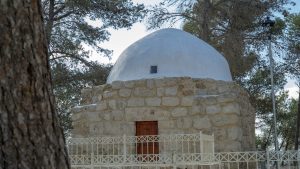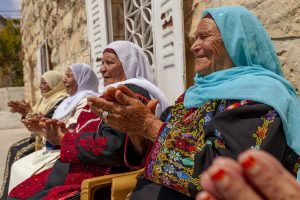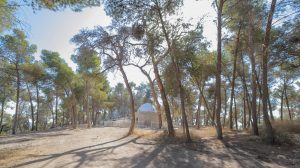The authenticity of heritage … the beauty of nature … and a variety of narratives
The vision of Rozana Association for Architectural Heritage focuses on villages animated by dynamic economies based on sustainable development and preservation of Palestine’s cultural and architectural heritage. Rozana started several years ago to be involved in the tourism sector through hosting cultural heritage events, initiating trails and tours, including Sufi trails, and engaging in community-building and achitectural heritage projects. Taking the theme “Palestine Tales of Hospitality” as its slogan, Rozana has worked to renovate historical sites such as Sheikh Sabe’ in Burqin, Dweir Shrine in Mekhmas (which is in the process of being renovated), and Nabi Ghaith Shrine in Deir Ammar, whose renovations have recently been completed. Although these shrines had been abandoned over the years, Rozana has worked to protect them through establishing public parks in the vicinity of the shrines and transforming these sites into tourist attractions for local and foreign visitors.
O Nabi Ghaith we have come to visit thee
Had it not been for your respect,
No one would ever visit thee
O Nabi Ghaith, thy months hath set in,
Had it not been for the dames,
No one would ever visit thee
O Nabi Ghaith, thy days hath set in
Had it not been for thy respect,
No one would ever visit thee

This is how the people of Deir Ammar – women, men, and children – sing for Nabi Ghaith every time they visit his shrine at the top of the mountain. According to Ratibah Al-Badha, Um Musa, born in 1935: “What I know is that Nabi Ghaith was a saint. Fifty years ago, about one hundred young men and women would go to visit [the shrine] every summer. We would go on foot. I was very young, and I used to accompany my parents. I would be dressed neatly. And I used to go out and sing with them.” The people of the town believed that Nabi Ghaith was a saint. They would invoke his blessing in their prayer for rain whenever rain was late. Um Musa adds: “We used to take along with us our ‘kit’ (like the scouts did). We would display long white banners bearing the name of God and some Qur’anic verses. Our prayer for rain was this:
O our Lord, bring rain to our village
O our Lord, we are very young to have sinned
These rituals – such as carrying banners, lanterns, and flags – are old customs and rituals practiced by the people of the region and not part of the Islamic religion.

The shrine is located at the top of the Mount of Spirits or Mount Ghaith, on the northern side of Deir Ammar. It encompasses an area of 25 square meters, whereas the entire area of the mountain is 33 dunams (a dunam is an Ottoman Turkish unit roughly equivalent to 1,000 square meters). The mountain is dotted with pine trees to mark the spatial boundaries of the shrine. The people associated the protection of the trees with the sanctity of the place and refrained from cutting down the trees for fear of the wrath of Nabi Ghaith.
Documenting the shrine’s history started somewhere around 1965. The most common narrative about Nabi Ghaith is that the shrine was built during the Ottoman mandate by the Turkish army to serve as a space for prayer. The shrine was then named after a Turkish solider, Ghaith, who was known for his devotion. Other stories told by the people of Deir Ammar insist that the mountain was bare, utterly without trees. It attracted a devout man named Ghaith more than five centuries ago. He decided to make it his home, as it was far from the village. He built a small house and planted pine trees in the surroundings. He spent his life in prayer and worship. After his death, people considered him to be a saint and began to invoke his blessing, believing that his prayers would be answered by God.

Nabi Ghaith Shrine is the starting point of a natural and easy five-kilometer hiking trail that heads towards Wadi Natouf. Beside the shrine, there are many water springs that feed the agricultural terraces with water. While roaming through the region, one can visit the Ayoub Spring, the agricultural terraces, the Roman olive trees, and the natural caves. The trail is considered to be one of the most inspiring trails for local cultural tourism which, in turn, enhances Palestinian heritage and identity. It’s a great one for foreign tourists as well.
For more information, contact Rozana Association for Rural Tourism, Birzeit – Old City, Tel: 02 281 9850; email: info@rozana.ps; http://rozana.ps; http://www.sufitrails.ps; FB: https://ar-ar.facebook.com/rozana.association/.


